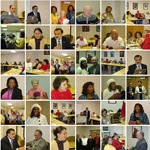Title: Intersections:Face to Face and Online presented by Dr Susan Miller, an Art Prof at SUNY
- discussed the transition from face to face to online, especailly in an ART course!!!!
- generally there is much resistance in this discipline, she said.
- students upload their artwork for class discusssion
- class participates via virtual discussion in Bb
- would students develop the competencies needed with tools such as digital camera, scanners, microphones?
- would they understand lighting issues so their work would show well (electronically)?
- will they learn to use art media appropriately ("when I am not there to watch them")?
Susan showed about 10 pieces of these students' work---beautiful ! We saw the actual pieces and the same pieces photographed digitally and uploaded to Bb. She said that it is easy for the prof to know if the student did as requested, used marker vs pencil vs charcoal vs water color.....
Someone asked, "How do you know they are doing their own work?
A: "They submit a portfolio at the end with all of the same pieces they have uploaded. The portfolio is 25% of the grade!
Susan provides online handouts (posted to Bb). The handouts are on content and how-to's. Students are encouraged to print these out. They do online exercises from these. They turn these exercises in as components of the portfolio. They also do online critiques of art, narrated powerpoints, use Wimba voice tool, and use streamed video clips to demonstrate techniques.
Dr miller reported that the discussions online are much more honest and rich. Students don't hold back the same way they do in the classroom.
She says that the posted assignments, notes, and other info, allows for repetition. Many students learn better because they now have the opportunity to see the info again (and again).
They use a certain software that alerts them to plagiarized work.
Her paper is among the compendium of papers on the conference papers CD, which I have. If you want it pls let me know.
Joanne Chesley
